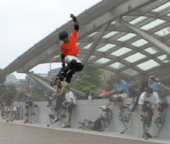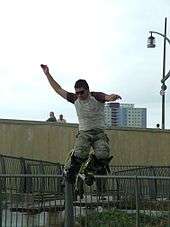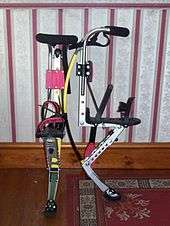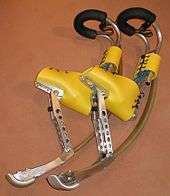Jumping stilts




Jumping stilts or spring stilts are special stilts that allow the user to run, jump and perform various acrobatics. Spring stilts using fiberglass leaf springs were patented in the United States in 2004 under the trademark "PowerSkip", marketed for recreational and extreme sports use.[1] Spring stilts are often mostly made of aluminium. Using these stilts is also called "bocking" or "powerbocking", a corrupted version of the name of the stilts' inventor, Alexander Boeck.
Powerbocking
The act of "bocking" or "powerbocking" includes jumping, running, and performing acrobatics with elastic-like spring-loaded stilts.[2] For some it is an extreme sport; for others it is a form of exercise or even artistic expression.
The stilts are often referred to generically as bocks or powerbocks; as power stilts, jumping stilts, or spring stilts; or by their brand name.
Description
Each boot consists of a foot-plate with snowboard type bindings, rubber foot pad which is also commonly called a hoof, and a fibreglass leaf spring. Using only their weight, and few movements, the user is generally able to jump 3–5 ft (1–1.5 metres) off the ground and run up to 20 mph (32 km/h). They also give the ability to take up to 9-foot (2.7 metres) strides.[3]
Jumping stilts were used in the closing ceremony of the 2008 Olympic games in Beijing.[4]
Brands
They were originally patented by Alexander Böck, from Germany (European Patent EP 1 196 220 B1 on 2 July 2003, US Patent No. 6,719,671 B1 on 13 April 2004, both with a priority date of 20 July 1999), as "Powerskip". Many people also use common brand names to refer to them generically.[5] Common brand names are 7 League Boots, Air-Trekkers, Powerizers, Pro-Jump, and Powerskips.
Risks
On 4 December 2010 Samuel Koch was heavily injured during the show Wetten, dass..? during a stunt where he attempted to jump over multiple moving cars in succession. He failed to clear one of the moving vehicles and was left tetraplegic after suffering severe injuries to his neck and spine.
Competition
Two competitions exist in France: the Nancy Power Days (since 2009) at Nancy[6] and the Riser Winter Cup (since 2015) at Lille.[7][8]
Similar devices
Though similar in appearance, powerbocking is not to be confused with the use of prosthetic devices such as those used by paralympic runner Oscar Pistorius.
Moon shoes and Kangoo Jumps are earlier attempts at jumping shoes using a different technique. Some are still popular today. Rocket boots were designed in the 1970s for the Russian Army, and use combustion pistons rather than springs for a similar effect.
Similar devices are attached to the boots of Chell (the protagonist) in the Portal video game series for the purpose of surviving long falls, though such devices might not actually work in real life.
An English folklore figure, spring-heeled Jack, has been conjectured by some investigators to have been a prankster using spring-loaded leaping aids as early as 1837.
Spring stilts using steel coil springs, an antecedent of the pogo stick, were attempted in the 19th century.[9][10]
References
- ↑ Alexander Böck (13 April 2004) U.S. Patent 6,719,671 "Device for helping a person to walk".
- ↑ "A Giant Step for Mankind". The Washington Post. 30 October 2007. Retrieved 22 May 2010.
- ↑ "Zebedee Workout". London: Daily Mail. 5 December 2006.
- ↑ "Beijing 2008 Olympic Video".
- ↑ See introduction on the forum: PoweriserPages.com
- ↑ "NANCY-POWER-DAYS-2016". Retrieved 10 February 2017.
- ↑ "Riser Winter Cup". Retrieved 10 February 2017.
- ↑ "Riser Winter Cup 2017 Trailer". Retrieved 10 February 2017.
- ↑ George H. Heerington (22 February 1881) U.S. Patent 238,042 "Spring-stilt"
- ↑ Nicholas Yagn (21 October 1890) U.S. Patent 438,830 "Apparatus for facilitating walking"
External links
| Wikimedia Commons has media related to Poweriser. |
- Jumping stilts at Curlie (based on DMOZ)
- Description of the PowerBockingdevice
- DoesWhat Powerizers Pro Jump video
- Google Patent for the original PowerSkip, by Alexander Boeck
- Image of man powerbocking on BBC
- w3BBO Bockipedia - The Bocking Encyclopedia
- Welsh Bockers - jumping stilts club based in Cardiff, UK